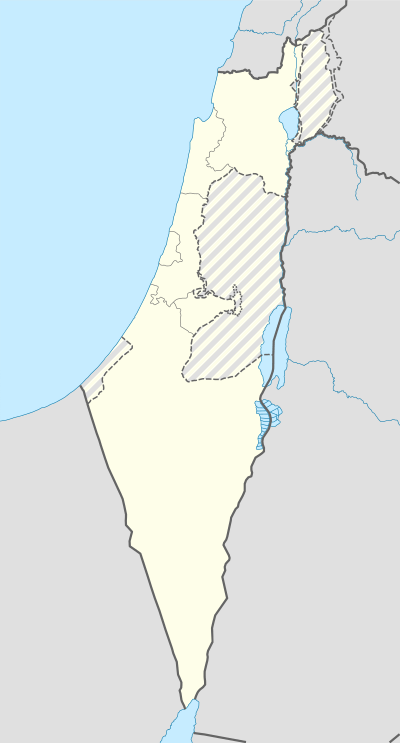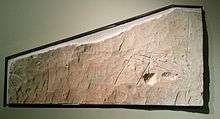Khirbet Beit Lei
| בית לחי | |
 | |
 Shown within Israel | |
| Alternate name | בית לויה |
|---|---|
| Location |
|
| Coordinates | 31°33′49″N 34°55′41″E / 31.563611°N 34.928056°E |
| Area | c.50 Dunams |
| History | |
| Periods | Iron Age II - Mameluke period |
Khirbet Beit Lei or Beth Loya is an archaeological tell in the Judean lowlands of Israel. It is located about 5.5 km southeast of Beth Guvrin on a hill 400 m above sea level.
History
During the construction of a road in 1961, an ancient burial complex was discovered ten miles west-northwest of Hebron. An archaeological expedition by the Israel Antiquities Authority led by Joseph Naveh of the Hebrew University of Jerusalem found a cave consisting of three chambers cut into the chalky limestone. Eight skeletons lay on limestone ledges around the sides of the chambers. A ring, a bronze earring and a bronze plaque were also found in the cave, which contained carved drawings and inscriptions. Three of the drawings were of human figures: a man holding what might be a lyre, a man raising his arms, possibly in a prayer gesture, and a man wearing a headdress. Two sailing vessels were sketched on another wall.[1]
Archaeology
Khirbet Beit Lei was first surveyed by R.A.S. Macalister of the Palestine Exploration Fund, who found a rock-cut chapel and burial caves.[2]
In 1961, two Iron Age II multi-chamber burial caves were excavated by Joseph Navehat in the eastern part of the site. The caves had been unearthed by road construction. One cave contained eight skeletons that had been untouched since being laid to rest. Drawings and inscriptions were carved into the walls of the cave.[1] The other cave had been looted at some point, and analysis revealed that the interred individuals belonged to a group of different origin than the first group. The drawings depicted three human figures, two ships, and two other figures that may be an encampment and a tent. The ships lead scholars to believe that the chambers were reused by Israelite refugees fleeing the Chaldaean armies in the sixth century BCE, probably Levites. Ships are a common motif in ancient Near Eastern burial chambers.
Between 1972 and 1973, the site was surveyed by Yehuda Dagan.[3] This survey revealed that the site had been settled from the Hellenistic period until at least the Mameluke period. No Iron Age remains were found.[4] A number of hewn subterranean installations, including columbaria, olive presses, water cisterns, quarries, a stable and hideaways are attributed to the Hellenistic and Roman periods.
From 1979 to 1983, Yotam Tepper and Y. Shahar investigated the caves at the site.[5]
In 1983 and 1986 Joseph Patrich and Yoram Tsafrir excavated a basilica church at the site, as well as an olive press, a wine press and a burial cave nearby,[6] on behalf of the Institute of Archaeology of the Hebrew University in Jerusalem. The church is thought to have been built around the year 500 CE, and to have functioned well into the 8th century. The church complex was thought to be on the outskirts of a village. The mosaic floors of the church reflect iconoclastic activity, and then repair.[7]
The excavations at the site were renewed in 2005 under the direction of the Oren Gutfeld, on behalf of the Institute of Archaeology of the Hebrew University in Jerusalem, with funding from a Mormon non-profit foundation.[8]
Hebrew inscriptions

Seven inscriptions in Hebrew remained in various states of preservation, and there is disagreement about how they should be read. It appears that the words YHWH (Yahweh) and YRSHLM (Jerusalem) feature in the inscriptions, which Joseph Naveh dated to the late 6th century BCE.[1][4]
Of particular interest is one inscription which is the oldest known appearance in Hebrew of the name ירשלם (Jerusalem).[1] Naveh read it as
יהוה אלהי כל הארץ, הרי יהד לו לאלהי ירשלם
which he translated as "Yahweh (is) the God of the whole earth; the mountains of Judah belong to him, to the the [sic?] God of Jerusalem".[1]
Frank Moore Cross disagreed with many of Naveh's readings of the letters, instead interpreting the inscription as a poetic rubric in the first person: "I am Yahweh thy God: I will accept the cities of Judah, and will redeem Jerusalem".[9] Cross speculated that it was "the citation of a lost prophecy", perhaps written by a refugee fleeing the 587 BCE destruction of Jerusalem.[9] Naveh later dismissed Cross's reading and stuck to his own version.[10]
Other scholars, including Lemair and Puech, have proposed additional readings. Patrick Miller read it almost the same as Cross did: "[I am] Yahweh your God. I will accept the cities of Judah. I will redeem Jerusalem."[11]
See also
References
- ↑ Macalister, R.A.S. (1901). "On a Rock Cut Chapel at Beit Leyi". Palestine Exploration Fund Quarterly Statement. London: PEF. 33: 226–230. Retrieved 28 March 2011.
- ↑ Yehuda Dagan (2006). Archaeological survey of Israel: Map of Amazya (109). The Northern Sector. Israel Antiquities Authority. pp. 101–104. ISBN 978-965-406-195-7.
- 1 2 "Patrich, Joseph; Tsafrir, Yoram (1992). E.Stern, ed. האנצקלופדיה החדשה לחפירות ארכיאולוגיות בארץ ישראל [The New Encyclopedia of Archaeological Excavations in the Holy Land] (in Hebrew). I. pp. 181–186.
- ↑ עמוס כלונר; יגאל טפר (1987). מערכות־המסתור בשפלת יהודה [Hiding Refuges in the Judean Shephelah]. Israel Exploration Society. pp. 131–136.
- ↑ Yoram Tsafrir (1993). Ancient churches revealed. Israel Exploration Society. pp. 265–272. ISBN 978-965-221-016-6. Retrieved 5 April 2011.
- ↑ Magness, Jodi. The Archaeology of the Early Islamic Settlement in Palestine. Eisenbrauns. p. 109. ISBN 978-1-4575-0070-1. Retrieved 24 March 2011.
- ↑ Beit Lehi Foundation, Beit Lehi (Horbat Beit Loya)—The 2008 Excavation Seasons. This foundation, which sponsored the excavation, believed there was a link between the site and the Book of Mormon character Lehi. The religious driven hypothesis of this foundation is disputed by both Mormon and non-Mormon archaeologists. See Chadwick, Jeffrey R. (2009). "Khirbet Beit Lei and the Book of Mormon: An Archaeologist's Evaluation". The Religious Educator. 10 (3): 17–48.. The archaeological reports of the foundation's web-site, however, are valuable academic reports written by the members of the Hebrew University of Jerusalem expedition. See also Hershel Shanks, Biblical Archaeology Review, November/December 1988, p. 19 (quoting Frank Moore Cross, who said the link was "based on a linguistic blunder").
- 1 2 Frank Moore Cross (1970). "The cave inscriptions from Khirbet Beit Lei". Near Eastern archaeology in the twentieth century : essays in honor of Nelson Glueck. Doubleday. pp. 299–306.
- ↑ Patrick D. Miller (2000). Israelite Religion and Biblical Theology: Collected Essays. Continuum. p. 222.